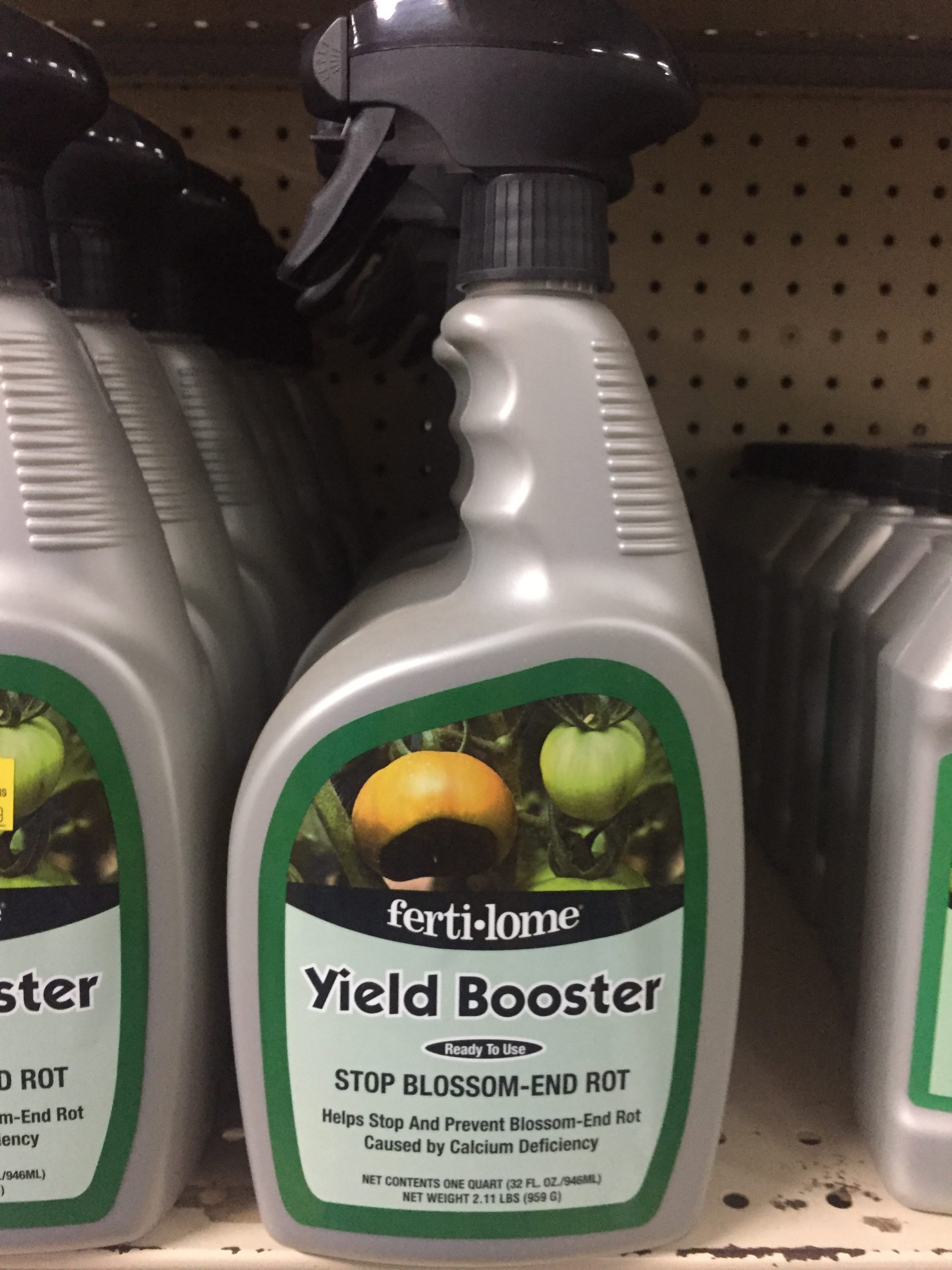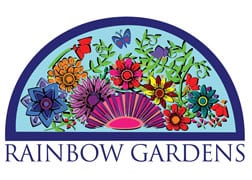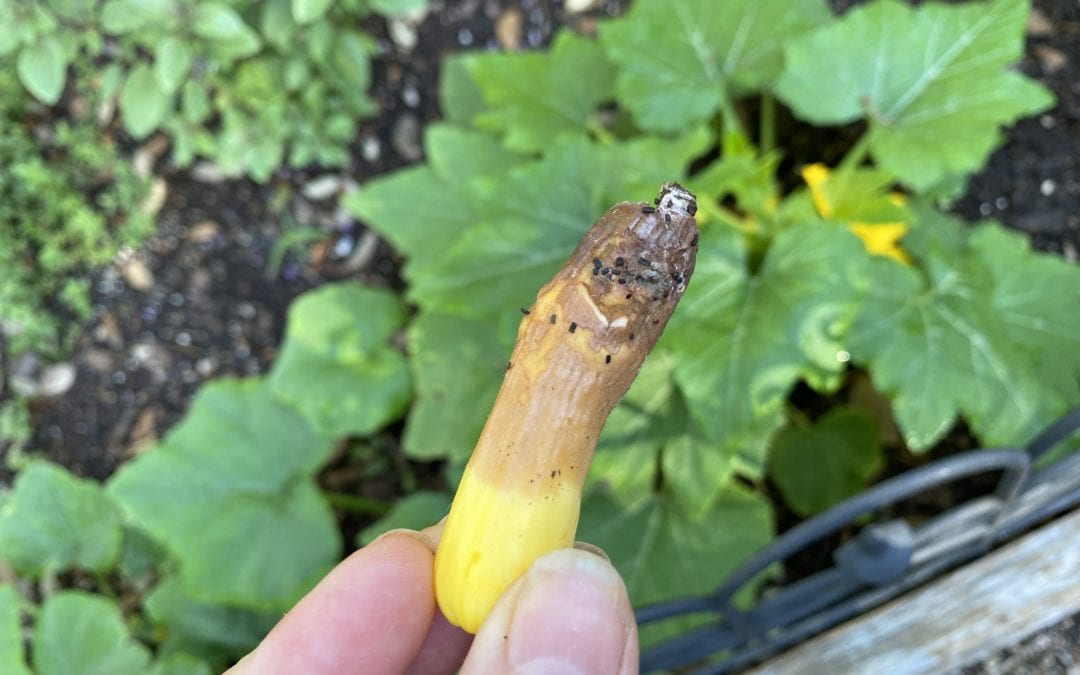Squash blossom end rot is one of those disorders that kind of slaps you in the face. It hurts! One day you are thrilled with the sight of a new squash growing on your plant and the next day you’re greeted with a shriveled, rotted, squishy, squash. I don’t know about you, but there is no room for squishy squash in my garden!
Blossom end rot doesn’t just happen to squash by the way. You can also find this problem creeping up on tomatoes, eggplant, peppers, watermelon and apples. I’m just using squash as an example because that’s what I encountered this morning. The good news about blossom end rot is that it is fixable. Yay! So let’s look at why blossom end rot happens, how it can be prevented and how it can be treated.
What is Blossom End Rot?
Blossom end rot, a physiological disorder not a disease, usually occurs due to one or both of the following two factors. Plants are either allowed to dry out too long between waterings, or plants affected are lacking a sufficient amount of calcium needed to build a stable structure.
Uneven watering. Allowing your garden to dry out too long before watering increase the likelihood of blossom end rot occurring. On the other hand, overwatering can also create problems. Feel your soil, and get on a regular watering schedule, factoring in rainfall. We’ve found most cases of blossom end rot on tomatoes have been caused by plants being allowed to excessively dry out between waterings.
Lack of calcium. When veggie plants lack calcium, their cell structure begins to collapse. The area most affected is usually towards the bottom half of the fruit.
Blossom end rot often presents on a plant’s earliest fruits, possibly before the plant’s root system has been able to really get established. You may first notice a discoloration on the ends of these early fruits that looks kind of like a water stain. As blossom end rot contiunes to develop the discoloration darkens and the fruit becomes misshapen and sunken in.
Treating and Preventing Blossom End Rot
If you’ve found you currently have blossom end rot:
- Remove the affected vegetables that currently have blossom end rot and begin a regular, consistent watering regime.
- Treat your plant with a foliar calcium spray, like Fertilome Yield Buster. This can help prevent your next round of squash from developing blossom end rot (as long as you are watering consistently too)
- Don’t over fertilize. Sometimes we get a little too excited about feeding our plants. Use a low nitrogen fertilizer formula, like FoxFarms Tomato & Vegetable 5-7-3 fertilizer (the “5” is the nitrogen content) and follow the recommendations for application amount and how often to fertilize on the bag. More is not better when it comes to fertilizing. You shouldn’t be trying to force your plants to grow at an unnatural pace.
- Our heirloom tomato grower, Keith Amelung, advises adding a handful of soft rock phosphate to the holes of vegetables as they are being planted. He doesn’t have issues with blossom end rot so there may be something to this.

One of the quickest remedies, besides watering consistantly, is to treat blossom end rot with a calcium spray.
Good Luck and Good Harvest!
~The Happy Gardener, Lisa Mulroy


I’m not with it
Can you suggest two products that have calcium?
That have soft rock phosphate ?
I CAN go buy Fertilome yield buxter
Gypsum provides a source of calcuim for a soil additive and soft rock phoshpate. Both of these items are available at our garden centers, as well as Fertilome yield booster.
Thank you for this super helpful article!
Absolutely! Thank you so much for reading our information!
Thank You for this article
You are so welcome! Thanks for reading and commenting.
Does egg shells in the garden give you calcium???
Hi Duane,
Sure they add some calcium to the soil. And they are great in compost bins or worm compost. But make sure you grind up those eggshells as fine as you can (use a food processor for ease). Studies have shown that that’s the best way to get the nutrients into the soil. Otherwise, eggshells can take a year or so to break down, leaving you with not much benefit. I also like to bake my eggshells just to make sure I’m not adding any bacteria into my gardens. 400 degrees for about 10 minutes should do it.
is soft rock phosphate the same as epsom salt
They are both long term mineral fertilizers but soft rock phosphate containing phosphorous and calcium, breaks down very slowly (some say one application will last a year). Epsom salt, containing sulfur and magnesium, is a very fast acting fertilizers but still considered long term, just not as long as soft rock phosphate, so you’ll apply it a few more times.
If you are asking in reference to the blossom end rot, the most recommended and efficient method to prevent blossom end rot is through consistent watering. The fertilizers definitely help too, but you could still end up with end rot if you don’t follow a regular watering schedule. Hope this helps.
Thank you for these tips , I was so excited to see all my squash blooms and little quash growing and then like over nite I have blossom end rot , We have been having lots of rain before the ground has a chance to dry it rains agin .could it be to much water?
Hi Brenda,
Yes, it very well could be that the excess water has caused the blossom end rot. Inconsistency in watering is the #1 culprit for this issue, so an influx of water like we had could definitely affect your squash. Was your garden bed amended with compost/peat moss, etc. at planting time? Have you had issues with water draining out of it before? I’m going to bet that once you are able to return to your regular watering schedule, you will be seeing those little squash growing again…this time without the blossom end rot!
I had the same problem with blossom end rot, i thought i did everything perfectly but here the past couple wks we hav had a lot of rain, i have great drainage I’m using grow bags this year,
I stick my fingers in the bag Apprx 4 inches and if its still moist below the 2 inches from top i dont water yet, i kno i used to water way to much, im trying to do better😊
HI Joyce!
Good for you for “doing better”! We all need to aim for that! Nothing you can do when the weather decides to take over and give us rain gushers! Keep up the good work, and let’s hope for the best with our veggies after all this rain. I love that you are using the best and most reliable moisture meter….your finger!
I have blossom end rot, I did the spray one evening and that night we got almost 5 inches of rain, shall I do the spray again after the rain?
Hi Darlene,
Check the label of your product. It should tell you the rain fastedness of the product. With this drought we are currently having, many of us are fighting blossom end rot. Try your best to stick to a consistent watering schedule. That is going to be your best bet to combat the problem on future squash development.
I’m having a problem with my Butternut Squash plants. The plant itself is doing fine – not wilting, but the flowers are dead. The flowers are not only dead, but are also brown and dried up. These flowers are the ones that would have the squash. When I touch the vine that goes from the flower to the plant, they feel squishy. Can you tell me what might be the problem. Thank you.
If it is not Blossom End Rot, you might have a squash borer issue. The eggs of these get laid upon the stem of squash and once hatched, burrow into the stem and begin feeding on plant material from the inside. Prevention is best. See my tips for preventing squash borer here.(Hint, use sticky gauze to wrap stems) Unfortunately by the time you realize you have it, it may be too late. Do you see anything that looks like sawdust around the base of the plant by the stem. This is usually a telltale sign of the borer.
Question for you. I live in New York City and we are having an infestation of those Spotted Lantern bugs and one home remedy is Dawn dish soap and water 50/50. I think I got a little aggressive spraying my zucchini, cucumbers and melon and the leaves got brown and dried out. I removed most of the affected leaves. Is it too late for my plants or will they come back from this? Thank you so much!
I don not know what the temperatures and weather conditions have been for you in New York as we are based here in San Antonio, Texas. However, it is scorching hot here and if you sprayed during the heat of the day, it is possible your plant has suffered from a chemical burn, even with a mild detergent such as Dawn. It’s a wait and see thing. Baby your plants as much as you can, offering them enough water and a dose of fertilizer to see if you can get some regeneration of leaves. water fertilizer in well when you apply. Let’s hope for the best!